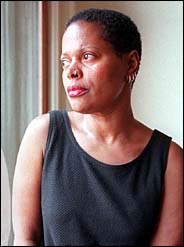
 |
| Sara Krulwich/The New York Times |
| Sapphire, a poet who took part in the society's program at Cooper Union on Tuesday. |
 n his poem "Mannahatta," Walt Whitman characterized that aboriginal name for New York City as "liquid, sane, unruly, self-sufficient." Taking its title from another line in that Whitman poem, the Poetry Society of America on Tuesday presented "The Words of My City," an anthology of New Yorkers reading New York poems. Whitman's seemingly contradictory words echoed through the evening.
n his poem "Mannahatta," Walt Whitman characterized that aboriginal name for New York City as "liquid, sane, unruly, self-sufficient." Taking its title from another line in that Whitman poem, the Poetry Society of America on Tuesday presented "The Words of My City," an anthology of New Yorkers reading New York poems. Whitman's seemingly contradictory words echoed through the evening.
The event, organized by Alice Quinn, executive director of the Poetry Society and the poetry editor of The New Yorker, took place in the Great Hall at Cooper Union and, she said, was intended "as an evening of many arts centered around poetry of the city." The readers included poets (Richard Howard, Sapphire, Willie Perdomo) as well as the choreographer Mark Morris (reading Frank O'Hara) and the actress Maria Tucci. Stephin Merritt played the ukulele and sang songs of the city.
As conjured up by poets, New York is a city of extreme contrasts: of dark underground tunnels and soaring skyscrapers, of slums and museums, of perpetual going-out-of-business signs and carefully cultivated roof gardens. There were so many subway poems — by Sharon Olds, Katha Pollitt and Langston Hughes, among others — as to make the audience think that the writers never took buses or taxis.
Actually there was one poem that referred to taxis, May Swenson's "At the Museum of Modern Art," offered by Ms. Tucci, the most evocative of the evening's readers. Looking out the window of the Modern, Ms. Swenson spies, "Non-objective taxis surging west, on Fifty-third/ liquefy in slippery yellows, dusky crimsons."
Amid the verse there were moments of visual imagery, highlighted by the work of the cartoonist Ben Katchor. On a screen he presented three comic strips of life in the city, additionally enlivening them with his own wry commentary. In the first strip, a tenant who weighs 200 pounds is assailed by his neighbors because his "physical presence poses a threat" to the structure of their century-old building.
Then Mr. Katchor chronicled the imaginary escapades of street artists dedicated to painting New York — doorways, monuments — with gold, an attempt, he said, at "gilding the city." Finally, he amusingly described an invaluable art collection of dried fruit (grapes, pears), preserved and handed down through the ages as if they were objects from a mummy's tomb.
Repeatedly the beauty of the city was affirmed, as opposed to the threat of violence. New York was seen as a kind of urban balancing act, with everything evening out after periods of flux.
Grace Paley read from Whitman's "Crossing Brooklyn Ferry" and Sara Teasdale's "Union Square" as well as her own work. In a parenthetical remark, she said that she did not feel fearful until she started to spend most of her time away from New York.
There was only one poem with a direct reference to the terrorist attack on the World Trade Center, "The Last Hours of Laódikê, Sister of Hektor," written and read by Nicholas Christopher. He explained that he had started to write the poem before that attack and it was about the siege of Troy. Finishing it later that year, he realized the contemporary parallels, and labeled it "a poem of Sept. 11":
Cold missiles and a rain
of embers accompany the men
who slide like shadows into the city . . .
There was a prophetic note in Muriel Rukeyser's 1962 poem "Waterlily Fire," read by Ms. Paley: "Towers falling. A dream of towers."
Many of the poems read at Cooper Union came from "Poems of New York," a new pocket-size Everyman's Library book selected and edited by Elizabeth Schmidt. In the introduction, Ms. Schmidt says that she began collecting poems for this book after 9/11. These poems "became directives for appreciating all we take for granted." She adds, "Poets who have written about New York are masters at preserving, and allowing us to cherish, moments of life in this theater of chance and change."